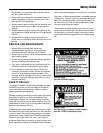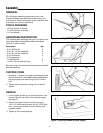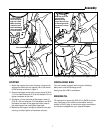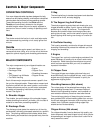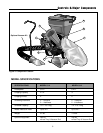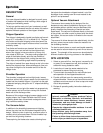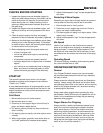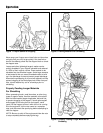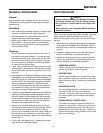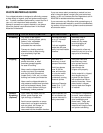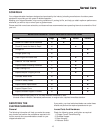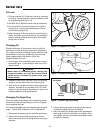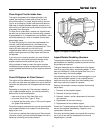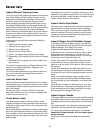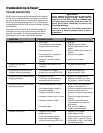
13
Operation
MATERIAL PROCESSING
General
Most materials to be processed can be handled more
efficiently by observing the following chipper/shredder
operating tips:
Shredding
1. Don’t overload the shredder hopper by dumping large
volumes of material into the hopper opening.
2. Alternate wet and dry material to prevent the dis-
charge chute from becoming plugged.
3. Never use any object to force material into the shred-
der chamber. It could get caught in the shredding
hammers and damage the unit, reducing shredder
hammer effectiveness.
Chipping
1. Prune tree limbs and large branches to limit size to
the maximum diameter allowed. Pruning tree limbs
and branches close to the main portion of the limb or
branch will make feeding into the chipper cone easi-
er, and will help you maintain control as the material
is drawn into the chipper block.
2. Large, hard, or dried-out tree limbs that tend to resist
chipping can be processed by rotating them manually
as you alternately insert and retract them in the chip-
per cone.
3. If the material to be chipped is extremely hard and kicks
back forcefully, or cannot be easily controlled while it is
being fed into the unit, remove the material immediately
and set it aside. You may need to sharpen the chipper
blades to process the material. Consult the mainte-
nance and service section of this manual for sharpen-
ing instructions, or take your unit to an authorized ser-
vice center for prompt, reliable service.
4. If normal chipping operation begins to require additional
feeding force to process material, the chipper knives
may be in need of routine sharpening. See the mainte-
nance and service section of this manual for sharpen-
ing instructions, or take your unit to an authorized ser-
vice center for prompt, reliable service.
5. Always try to maintain adequate control of the tree
limbs and branches being fed into the chipper cone to
prevent them from whipping around and causing
injury to you or damage to the cone. Larger limbs and
branches may have a tendency to kick back toward
the operator, so always be alert as you feed materials
into the cone.
6. Cut any left-over material into 1" pieces and process
them through the shredder hopper.
SHUTTING DOWN
When you’re done using the chipper/ shredder, following
these simple but worthwhile steps will help you shut
down the unit properly so that your next use will be trou-
ble-free.
1. When you have completed processing the materials
to be chipped or shredded, shut the engine off and
allow the rotor to come to a complete stop before pro-
ceeding.
2. Remove the spark plug wire from the spark plug to
prevent the possibility of inadvertent starting.
3. Inspect the following areas for any remaining materi-
als that may have built up or become caught during
the final chipping and shredding operations:
• SHREDDER HOPPER
Visually inspect inside of shredder hopper, and
remove any material remaining inside.
• CHIPPER CONE
Visually inspect chipper cone to ensure that there
are no pieces of tree limbs, branches, or any other
debris remaining inside. Remove and discard this
debris.
• DISCHARGE CHUTE
Lift the discharge deflector, and inspect the chute
for clogs or other build up, and remove as
required. This area is most likely to require clean
out if wet or green organic materials have been
shredded.
• ENGINE RECOIL STARTER AREA
This area of the engine is also the intake for the
motor’s air cooling fans. Remove any build-up of
grass or shredded material that may have accu-
mulated around the intake openings. Use care to
prevent build-up from being pushed into the intake
area during cleaning.
DANGER
Engine and surrounding parts become extremely
hot during normal use, and will cause serious
burn injuries if touched before the engine has
cooled.
Allow engine to cool completely before touching
these hot surfaces.



